Introduction: The Foundation of Strength for the Modern Man Weight Lifting
In the world of fitness, the image of a man weight lifting remains a symbol of commitment, discipline, and transformation. But beyond the aesthetics lies a deeper pursuit—the development of true strength, power, and resilience. Strength training isn’t just about building muscle; it is about cultivating a foundation for longevity, confidence, and performance in every area of life. For any man weight lifting with intention, success is found in structure, science, and sustainability. This guide is designed to provide a roadmap for building strength and power from the ground up, blending proven techniques with emerging insights, and bridging the gap between aspiration and achievement.
You may also like: The Ultimate 30-Day Workout Plan for Men Working Out in the Gym: Proven Full Body Strength Exercises to Maximize Results
Understanding the Physiology Behind Strength and Power
Before exploring training plans and exercises, it is essential to understand what strength and power truly represent at the physiological level. Strength is the ability to produce force, while power is the ability to produce force quickly. They both rely on a combination of muscular size, motor unit recruitment, and neural efficiency. Resistance training increases the cross-sectional area of muscle fibers (hypertrophy), but also trains the nervous system to activate more muscle fibers more efficiently.
For a man weight lifting consistently, adaptations such as increased muscle fiber recruitment, enhanced tendon stiffness, and improved intra- and inter-muscular coordination are key. Power training, which includes movements like Olympic lifts, jump squats, and medicine ball throws, adds a speed component to this equation. These adaptations don’t happen overnight, and understanding the science allows lifters to make informed decisions about rest periods, loading strategies, and volume management. Strength and power aren’t just about lifting heavy; they are about doing so in a way that aligns with the body’s capacity to grow stronger and more explosive over time.

Periodization Strategies Every Man Weight Lifting Should Follow
To avoid stagnation and optimize results, every man weight lifting for strength must apply periodization. This refers to the systematic variation of training intensity, volume, and exercise selection over time. Linear periodization increases intensity while decreasing volume over a series of weeks or months. This is ideal for beginners who need to build a base. In contrast, undulating periodization alternates intensity and volume within a training week, making it effective for intermediate or advanced lifters.
Another advanced approach is block periodization, where training blocks focus on specific adaptations: hypertrophy (muscle growth), strength (maximal load), or power (explosiveness). Each block is typically three to six weeks in length and flows logically into the next. Strategic deloads are built into these cycles, allowing the nervous system and connective tissues time to recover. Periodization not only helps maximize gains but also minimizes the risk of injury or burnout—a critical concern for any long-term man weight lifting plan.

Core Principles Behind Good Exercises for Men Building Strength
When crafting a strength program, selection of exercises is paramount. Good exercises for men pursuing strength are those that involve multiple joints, large muscle groups, and movement patterns that mirror real-life physical demands. Compound lifts like squats, deadlifts, bench presses, and overhead presses are foundational. They stimulate large volumes of muscle tissue and elicit robust hormonal responses.
However, exercise quality goes beyond the barbell. Movements like weighted pull-ups, barbell rows, lunges, and farmer’s carries are also highly effective. These exercises challenge balance, grip, and core stability while building upper and lower body strength in unison. Advanced lifters can integrate Olympic variations, loaded carries, and rotational core work to round out their regimen. When done with proper technique and progressive overload, these movements form the backbone of any successful strength protocol. Choosing good exercises for men means prioritizing effectiveness over novelty, ensuring each lift contributes to long-term development.

Building a Weekly Template for the Man Weight Lifting Long-Term
A consistent and structured weekly training template is essential for progress. A well-rounded routine for a man weight lifting seriously will typically include three to five resistance training sessions per week. Beginners might focus on full-body workouts every other day, while advanced lifters can adopt split routines that allow for targeted work and adequate recovery.
A balanced weekly plan might include: Day 1: Lower body strength; Day 2: Upper body push; Day 3: Rest or active recovery; Day 4: Upper body pull; Day 5: Power/mobility or metabolic conditioning. This structure allows for varied stimulus and recovery, addressing all major movement patterns. Volume and intensity should be modulated throughout the week, preventing overtraining while promoting steady progress. Flexibility is key; plans should accommodate individual schedules, recovery capacity, and life demands.
Programming Power Development into a Strength Routine
Power development is often neglected by recreational lifters but is essential for athleticism and injury prevention. For a man weight lifting to maximize his potential, power exercises should be incorporated early in the training session, when the nervous system is fresh. Exercises like box jumps, kettlebell swings, clean pulls, and medicine ball throws enhance rate of force development—the speed at which muscles can contract and generate force.
Power movements should be performed explosively, with light to moderate loads and low reps. Rest between sets should be long enough to maintain intensity, typically two to three minutes. Programming power into strength training doesn’t require a separate day; it can precede heavy compound lifts or be used as a dynamic warm-up. Integrating power training ensures the man weight lifting not only gets stronger but also more agile, reactive, and functionally capable.

Recovery and Regeneration Strategies for Strength Athletes
Recovery is the unseen pillar of performance. For the man weight lifting several times per week, active recovery, sleep, nutrition, and mobility work are as crucial as the training itself. Sleep should be prioritized above all else; it is during deep sleep stages that testosterone and growth hormone spike, driving muscular repair and adaptation. Most lifters require at least seven to nine hours per night for optimal function.
Nutrition supports recovery through calorie sufficiency, protein intake, and micronutrient balance. Supplements like creatine, magnesium, and omega-3s may assist in reducing inflammation and improving muscle recovery. Soft tissue work, such as foam rolling, massage, or even acupuncture, can accelerate recovery by improving circulation and reducing tension. Cold plunges and contrast therapy also have growing support. Programming regular deload weeks and monitoring signs of overtraining are essential for long-term sustainability.

Addressing the Mental Game for Every Man Weight Lifting
The psychological component of strength training is often underestimated. A man weight lifting with long-term goals must build not only physical resilience but mental toughness. Developing the mindset to train consistently through discomfort, plateaus, and life interruptions is paramount. Goal setting, visualization, and positive self-talk are tools that help reinforce motivation and adherence.
It’s also important to embrace a long-term view. Strength is built over months and years, not weeks. Accepting this fosters patience and reduces the temptation to chase short-term gains at the expense of form or recovery. Mental burnout can be mitigated through variation in programming, rest periods, and training environments. Ultimately, success in the gym mirrors success in life: showing up consistently, adapting under pressure, and progressing even when it’s hard.
Customizing Your Approach to the Best Good Exercises for Men
The best training plan is one that fits your needs, not someone else’s template. While there are universally good exercises for men, individual biomechanics, mobility, goals, and training history must guide selection and progression. For example, not every man can safely perform deep barbell back squats—alternatives like front squats, trap bar deadlifts, or Bulgarian split squats may be more appropriate.
Adjustments should also be made based on training age. Novices benefit from simplicity and repetition, mastering foundational lifts before progressing to more complex variations. Intermediate and advanced lifters can benefit from more nuanced periodization and advanced accessory work targeting weak points. Equipment access, time constraints, and injury history all play a role in what constitutes the “best” workout. Personalization elevates the effectiveness and sustainability of any man weight lifting for long-term health and performance.
Optimizing Nutrition to Support Strength and Power
Nutrition is the fuel that powers performance and recovery. For a man weight lifting regularly, caloric intake must match expenditure to support muscle growth and energy demands. Protein is the most critical macronutrient, with recommendations ranging from 1.6 to 2.2 grams per kilogram of body weight daily. This supports muscle repair, immune function, and enzyme production.
Carbohydrates restore glycogen and provide the energy needed for high-intensity work. Timing carbs before and after workouts enhances performance and recovery. Healthy fats support hormone production, particularly testosterone, which is vital for muscle growth and recovery. Micronutrients such as zinc, vitamin D, and magnesium play critical roles in nerve conduction, muscle contraction, and metabolic efficiency.
Hydration affects muscular endurance and cognitive function; even mild dehydration can impair performance. Supplements should be used strategically, not as a replacement for food. Whey protein, creatine, beta-alanine, and caffeine are among the most evidence-supported aids. The goal is to fuel the body to train hard, recover fast, and grow strong.

Adapting Training Through the Lifespan: A Guide for the Aging Man Weight Lifting
Strength training becomes even more important with age. As men age, muscle mass, bone density, and testosterone levels decline. For the man weight lifting in his 40s, 50s, and beyond, the goals shift slightly: maintain lean mass, preserve joint integrity, and support metabolic health. Training must adapt to account for longer recovery times and increased injury risk.
Exercises that emphasize controlled movement, full range of motion, and joint stability should be prioritized. Resistance bands, machines, and bodyweight variations offer safe, effective alternatives to heavy free weights. Recovery techniques, including more frequent deload weeks and emphasis on mobility, become increasingly important. Nutrition also takes center stage, with a focus on anti-inflammatory foods, adequate protein, and bone-supportive nutrients like calcium and vitamin D.
Strength doesn’t need to decline with age—in fact, many men achieve personal bests well into midlife. The key is to train smart, stay consistent, and listen to your body. Aging is inevitable; decline is not.

Frequently Asked Questions: The Ultimate Guide to Building Strength and Power for Every Man Weight Lifting
1. What Are the Most Underrated Yet Good Exercises for Men Focused on Functional Strength?
While compound lifts dominate most strength programs, there are several highly effective but underutilized movements that deserve more attention. Good exercises for men looking to improve functional strength include loaded carries like farmer’s walks, which train grip, posture, and total-body tension. Turkish get-ups challenge coordination, core stability, and shoulder mobility in a uniquely integrated way. Sled pushes and pulls are also outstanding for developing explosive power without the joint stress of traditional lifts. These exercises mirror real-world movement and help build a resilient body capable of enduring life’s physical challenges.
2. How Can a Man Weight Lifting Improve His Strength Without Gaining Excess Bulk?
Not every man weight lifting wants to increase muscle size dramatically. To focus on strength without hypertrophy, one should train with heavier loads (85%+ of 1RM) for low repetitions and longer rest periods between sets. This approach emphasizes neural adaptation rather than muscle volume. Additionally, maintaining a calorie-neutral or slight deficit diet prevents unwanted mass gain. Prioritizing compound movements, avoiding excessive accessory work, and keeping training volume moderate can help a man develop strength and efficiency without significant increases in muscle size.
3. Is It Safe for Older Adults to Begin a Man Weight Lifting Program?
Absolutely. In fact, strength training is one of the most impactful interventions for healthy aging. For an older man weight lifting for the first time, starting with a professional assessment and supervised sessions is advisable. Exercises should emphasize control, full range of motion, and joint stability. Resistance bands, machines, and bodyweight movements are good exercises for men over 50 who are developing foundational strength. Over time, training can be intensified to preserve muscle mass, bone density, and metabolic health, all of which decline with age if left unchallenged.
4. What Role Does Grip Strength Play for the Man Weight Lifting Seriously?
Grip strength is more than just a measure of hand endurance; it reflects overall neurological output and is linked to long-term health outcomes. For a man weight lifting heavy, a weak grip can become a limiting factor on deadlifts, rows, pull-ups, and carries. Improving grip involves incorporating exercises such as towel pull-ups, fat grip training, and barbell holds. Additionally, reducing reliance on lifting straps during submaximal sets can help build raw grip capacity. Consistent grip training not only enhances lifting ability but also reduces the risk of forearm and elbow injuries.
5. How Should a Man Weight Lifting Adjust His Routine During Periods of High Stress or Poor Sleep?
Chronic stress and sleep deprivation impair recovery, hormone regulation, and cognitive function. During these times, a man weight lifting should scale back intensity and volume. Opting for maintenance-level workouts with moderate weights and reduced frequency can help avoid overtraining. Mobility work, light cardio, and movement-focused sessions allow continued engagement without additional systemic stress. Recovery-enhancing strategies like breathwork, stretching, and cold exposure can also support the body’s stress response. Recognizing when to pull back is a sign of maturity and long-term thinking in a serious strength program.
6. What Are the Best Techniques to Improve Lifting Efficiency for a Man Weight Lifting Alone?
Training solo can limit real-time feedback, so focusing on technique is crucial. Video analysis is a valuable tool—record lifts and review form post-session. Emphasizing tempo control, particularly in eccentric phases, builds motor control and strength simultaneously. Good exercises for men training alone often include machine-based variations and unilateral movements, which lower the risk of imbalance and injury. Self-cueing, using mirrors strategically, and maintaining detailed training logs help ensure consistent progress. Autoregulation techniques like RPE (rate of perceived exertion) empower lifters to adapt based on how they feel that day.
7. How Frequently Should a Man Weight Lifting Train Each Muscle Group for Optimal Strength?
The ideal frequency varies based on training experience, volume, and recovery capacity. Beginners often benefit from full-body workouts three times per week, hitting each muscle group with high frequency and moderate intensity. For intermediate and advanced lifters, training muscle groups twice per week has been shown to optimize strength gains. Splitting sessions into upper-lower or push-pull splits ensures balanced development and adequate recovery. Good exercises for men should be rotated strategically within these sessions to address all movement patterns and muscular functions.
8. What Emerging Trends Should a Modern Man Weight Lifting Be Aware Of?
Strength training is evolving with insights from sports science, neuroscience, and digital coaching. Velocity-based training (VBT) is gaining popularity, using real-time bar speed data to adjust loads dynamically. Blood flow restriction (BFR) training is another tool that enables muscle hypertrophy at lighter loads, helpful during recovery or injury. Technology-driven feedback tools like wearables and mobile apps now offer detailed insights into recovery, stress, and readiness. A modern man weight lifting with intent should also follow nutrition innovations like intra-workout hydration protocols and sleep-optimization supplements. Integrating these advancements enhances efficiency and individualization.
9. What Psychological Benefits Come with a Man Weight Lifting Consistently?
Consistent strength training rewires the brain as much as the body. A man weight lifting regularly experiences increased dopamine and serotonin levels, which elevate mood and reduce anxiety. Lifting builds self-efficacy, a psychological cornerstone of confidence, by providing measurable and repeatable successes. Moreover, it cultivates discipline, structure, and a growth mindset that often transfers into professional and personal life. The act of committing to training despite discomfort teaches resilience and mental fortitude, reinforcing emotional stability and purpose.
10. How Can a Man Weight Lifting Maintain Motivation Over the Long Haul?
Sustaining motivation requires more than willpower—it demands systems. A man weight lifting consistently should set evolving goals, such as improving technique, increasing load, or mastering new lifts. Training with a partner or coach introduces accountability and renewed energy. Rotating phases and good exercises for men keeps training fresh and avoids stagnation. Celebrating non-scale victories, tracking progress visually or with data, and connecting training to larger life values (such as fatherhood, health, or career stamina) adds deeper meaning. Ultimately, progress is addictive when it’s pursued with clarity and joy.
Conclusion: Redefining Strength for Every Man Weight Lifting
True strength is not just about numbers on the barbell; it’s about integrity, resilience, and consistency. For the man weight lifting with purpose, the journey toward power and physical capability becomes a metaphor for personal evolution. This guide has outlined the physiological principles, programming strategies, nutritional guidelines, and mental frameworks necessary to support that journey.
Whether you’re a beginner just starting out or a seasoned lifter refining your edge, the path to strength is shaped by commitment to process and willingness to adapt. There are many good exercises for men, but the real differentiator is how consistently and intelligently they are applied. Strength is a practice, not an outcome.
Ultimately, building strength is about becoming a better version of yourself. With a thoughtful approach, expert insights, and the courage to challenge your limits, every man weight lifting can unlock extraordinary physical and personal potential. This is not just a guide—it’s an invitation to rise.





